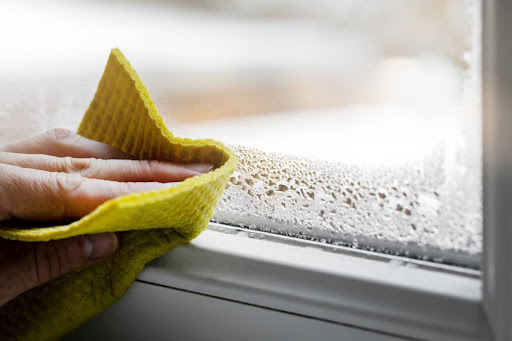Have you ever noticed how some parts of your home just feel right? Your couch is perfectly broken in, the lighting in the living room is warm but not too bright, and the temperature inside is always just the way you like it. A comfortable home is all about balance, and one thing that plays a huge role in that balance — often without you even realizing it — is humidity.
Too much moisture in the air, and your home starts to feel stuffy. Too little, and suddenly everything feels dry, from your skin to your throat. So, what is the ideal humidity level for your home? Finding that sweet spot makes a huge difference in how comfortable you feel, how well you sleep, and even how well your home holds up over time. Let’s break it all down.
What Is the Ideal Humidity Level for Your Home?
The ideal humidity level for your home usually falls between 30% and 50%. This range helps maintain good indoor air quality and prevents problems that can arise from humidity being too high or too low.
If the humidity level drops too much, dry air can cause chapped lips, sore throats, and dry skin. If it climbs too high, you might start to notice mold growth, dust mites, and excess moisture collecting on windows and walls. Neither extreme is great for your home or your health.
Keeping the humidity in that ideal indoor humidity level range helps prevent damage to furniture, protects musical instruments, and makes your house feel more comfortable year-round.
Normal Humidity Level in a Home Throughout the Year
Humidity levels fluctuate depending on the season. In the summer, hot air holds more moisture, so indoor humidity levels naturally rise. In the winter, cold air carries less moisture, which can make indoor air feel extra dry.
Here’s a rough guide to what’s considered a normal humidity level in a home during different times of the year:
- Winter: 30% – 40%
- Spring & Fall: 40% – 50%
- Summer: 50% – 55%
If humidity levels fall outside of these ranges, you might start noticing static electricity, respiratory problems, or even structural integrity issues in your home.
Best Humidity Level for Sleeping
You might not think much about humidity levels when you crawl into bed, but they play a big role in how well you sleep.
The best humidity level for sleeping is typically between 30% and 50%. This range keeps your airways from drying out, reduces the risk of respiratory illnesses, and helps prevent dust mites and mold spores from thriving in your bedroom.
If humidity levels are too low while you sleep, you might wake up with a sore throat, dry nose, or chapped lips. If humidity is too high, your bedroom can feel muggy, and you might even notice condensation on windows, which can lead to mold issues over time.
To keep your bedroom at the best humidity level for sleeping, you might need to use a whole-home humidifier in the winter or a whole-home dehumidifier during the summer.
Signs Your Home’s Humidity Levels Are Off
Are you unsure if your home humidity levels are in check? Here are some signs that they might be too high or too low:
Signs of Low Humidity:
- Dry skin, chapped lips, or sore throat
- Static electricity (shocking yourself every time you touch a doorknob)
- Cracking wood furniture or floors
- Respiratory conditions feeling worse than usual
Signs of High Humidity:
- Condensation on windows
- Musty odors (a sign of mold growth or mildew)
- Increased dust mites or allergies
- Peeling paint or wallpaper
If you notice these issues, it might be time to measure humidity in your home using a hygrometer, a simple tool that helps you monitor humidity levels.
How to Control Humidity in Your Home
Maintaining the ideal humidity level in your home doesn’t have to be complicated. With a few simple adjustments, you can keep your space comfortable all year long.
If Humidity Is Too Low:
- Use a whole home humidifier to add moisture to the air.
- Place bowls of water near heating vents to increase humidity naturally.
- Run a humidifier in your bedroom for better sleep.
- Add moisture-loving plants like peace lilies or ferns.
If Humidity Is Too High:
- Run your air conditioner to help remove moisture.
- Use exhaust fans in the kitchen and bathroom.
- Invest in a dehumidifier to reduce humidity levels.
- Improve proper insulation and ventilation to let in fresh air.
How HVAC Systems Help Maintain Home Humidity
Your HVAC system plays a big role in maintaining the optimal humidity levels in your home.
- Air conditioning units naturally help remove excess moisture in the summer.
- A well-maintained heating system keeps indoor humidity from getting too low in the winter.
- Whole-home solutions like humidifiers and dehumidifiers work with your HVAC system to balance humidity levels.
Regular HVAC maintenance keeps everything running smoothly and prevents issues like too much moisture or low indoor humidity from becoming a problem.
Keep Your Owensboro Home Comfortable Year-Round!
Humidity might not be something you think about every day, but it affects everything from indoor comfort to air quality and even your home’s structural integrity. If you’ve noticed humidity issues in your home — whether it’s dry air, excessive moisture, or mold growth — it might be time to make a change.
At Efficient Air Heating & Cooling, we offer a wide range of indoor air quality services in Owensboro, KY, and the surrounding areas. If you’re working toward the ideal humidity level for your home, our services include whole-house humidifier installations. We’ll walk you through the different options and assist you in choosing the best solutions for your home.
Need heating services in Owensboro, KY? We can make sure your system is running smoothly and keeping you warm without drying out your home. Schedule an appointment today!


Recent Comments